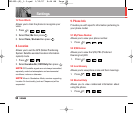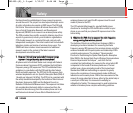
64 VX340064 VX3400
Safety
level that is hazardous to the user. In such a case, the FDA
could require the manufacturers of wireless phones to notify
users of the health hazard and to repair, replace, or recall the
phones so that the hazard no longer exists.
Although the existing scientific data do not justify FDA
regulatory actions, the FDA has urged the wireless phone
industry to take a number of steps, including the following:
●
Support needed research into possible biological effects of
RF of the type emitted by wireless phones.
●
Design wireless phones in a way that minimizes any RF
exposure to the user that is not necessary for device
function.
●
Cooperate in providing users of wireless phones with the
best possible information on possible effects of wireless
phone use on human health.
The FDA belongs to an interagency working group of the federal
agencies that have responsibility for different aspects of RF
safety to ensure coordinated efforts at the federal level. The
following agencies belong to this working group:
●
National Institute for Occupational Safety and Health
●
Environmental Protection Agency
●
Occupational Safety and Health Administration
●
National Telecommunications and Information
Administration
The National Institutes of Health participates in some
interagency working group activities, as well.
The FDA shares regulatory responsibilities for wireless phones
with the Federal Communications Commission (FCC). All phones
that are sold in the United States must comply with FCC safety
guidelines that limit RF exposure. The FCC relies on the FDA and
other health agencies for safety questions about wireless phones.
The FCC also regulates the base stations that the wireless
phone networks rely upon. While these base stations operate at
higher power than do the wireless phones themselves, the RF
exposures that people get from these base stations are typically
thousands of times lower than those they can get from wireless
phones.
Base stations are thus not the subject of the safety questions
discussed in this document.
33.. WWhhaatt kkiinnddss ooff pphhoonneess aarree tthhee ssuubbjjeecctt ooff tthhiiss uuppddaattee??
The term “wireless phone” refers here to handheld wireless
phones with built-in antennas, often called “cell”, “mobile”, or
“PCS” phones. These types of wireless phones can expose the
user to measurable Radio Frequency energy (RF) because of the
short distance between the phone and the user’s head.
These RF exposures are limited by FCC safety guidelines that
were developed with the advice of the FDA and other federal
health and safety agencies. When the phone is located at
greater distances from the user, the exposure to RF is drastically
lower because a person's RF exposure decreases rapidly with
increasing distance from the source. The so-called “cordless
phones”, which have a base unit connected to the telephone
wiring in a house, typically operate at far lower power levels,
and thus produce RF exposures far below the FCC safety limits.
VX3400-(E)_1.3.qxd 1/12/07 8:44 AM Page 64


















